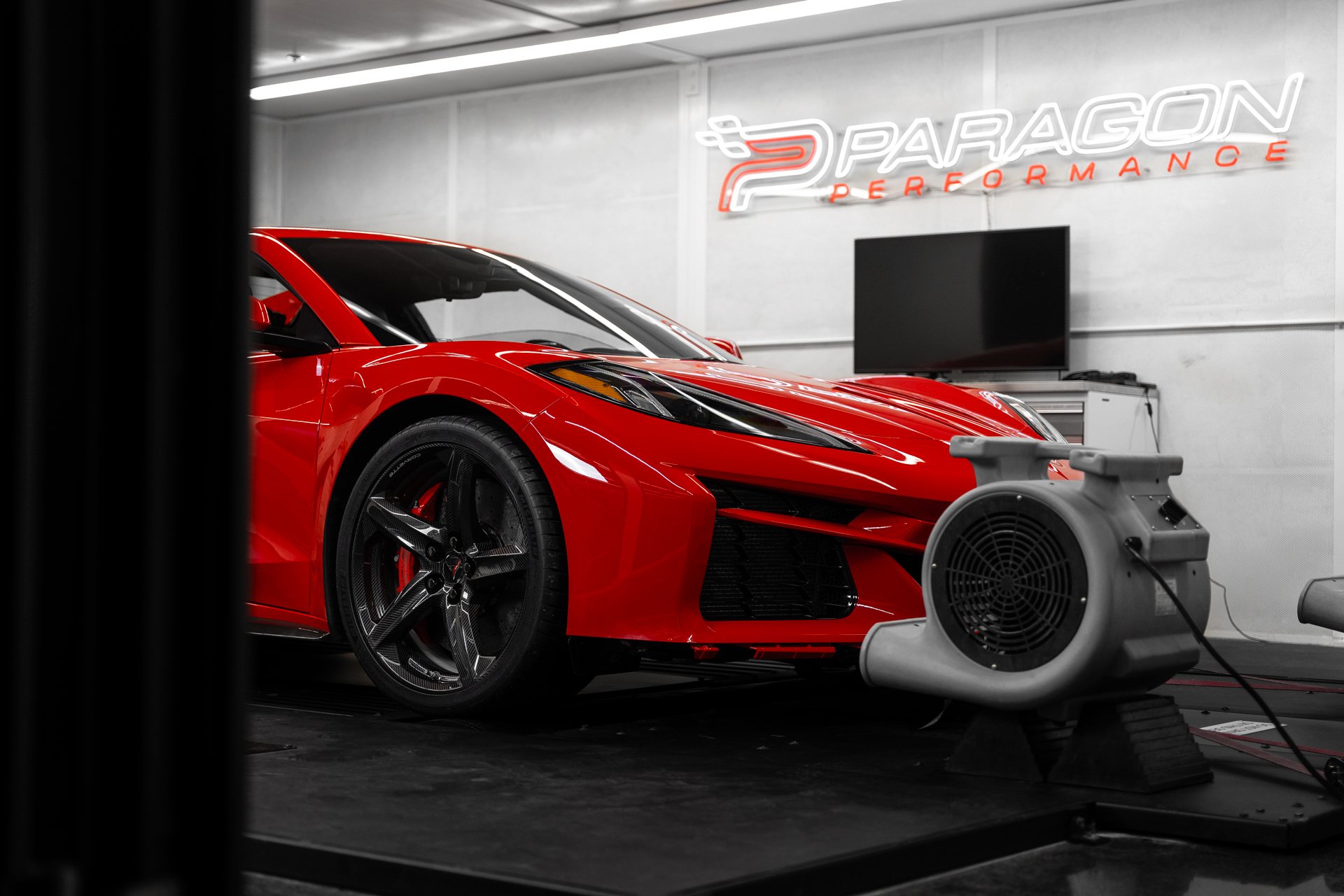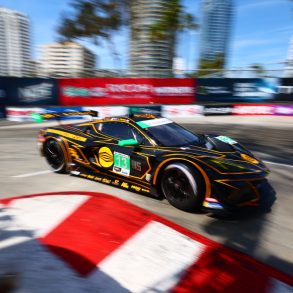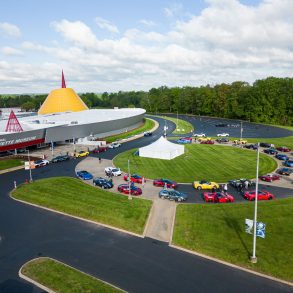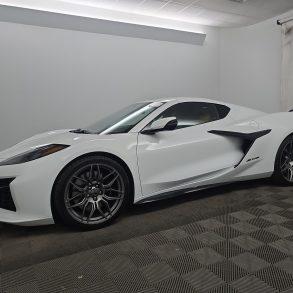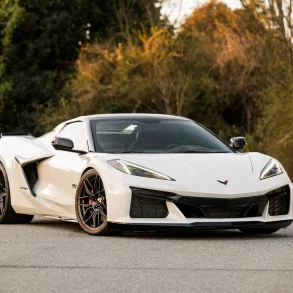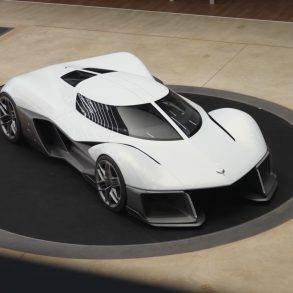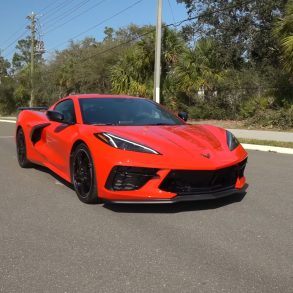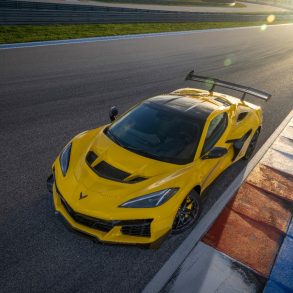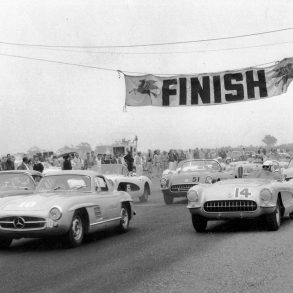The Corvette C8 E-ray is, to say the least, a pretty divisive car in the eyes of enthusiasts. In an almost 50/50 split, there are those that love it, seeing it as a sign of the future of the Corvette name, while there are also those that hate it, and think that the C7 was the last “real” Corvette. We won’t wade into that particular discussion, but one thing that those that have an order in for an E-Ray may be happy to know is that it is powerful.
Very powerful.
Customers have recently started receiving their deliveries of the all new hybrid, and of course, as with all things American and V8, a trip to the dyno after the initial 600 mile break in period was over was on the books! However, before we can dig into the numbers, we need to see how the E-Ray works.
How The Drivetrain Works, Simplified
The Corvette C8 E-Ray falls into the category of “performance hybrid.” This is a car, usually with the word “Sports” or “Super” in front of it, that instead of using a hybrid electric motor to help save gas uses it to accentuate the power of the engine, in this case a V8.
Most of the fuel saving hybrids put the electric motor right next to the gas engine, using it to reduce the effort of moving away from a stop, cruising at freeway speed, and generally just being a helpful all around. In a performance hybrid such as the E-Ray, there often is no physical connection between the motor and the engine, especially with the motor up front driving the front axle, and the engine in the back driving the rear axle.
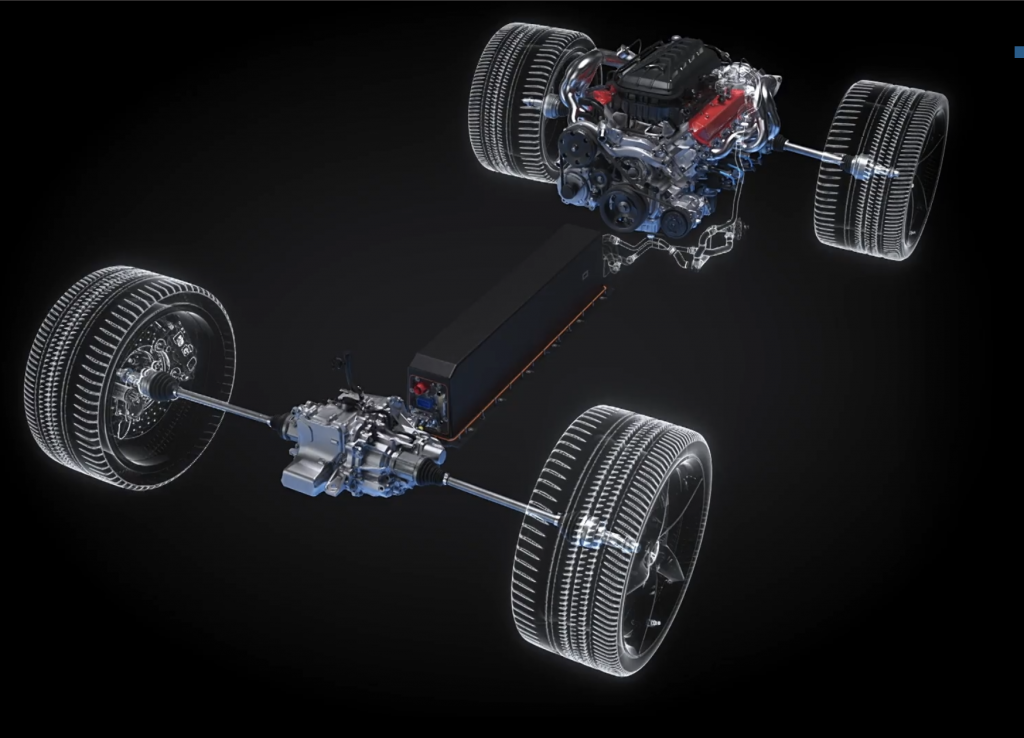
Because of this, the E-Ray has two driving modes that are specific to it, on top of the standard tour, sport, and track modes in the standard C8. The first of these is “Stealth,” which is an EV only mode that doesn’t have the V8 fired up at all, and can get up to 50 MPH with about 3-5 miles of range. Basically, if you’re a little late coming home from hooning your E-Ray around some canyon roads, this lets you pull into the neighborhood without waking everyone up.
The other mode is “Shuttle,” which is a power restricted mode that again only uses the electric motor. However, push the pedal to the mat all you want, the V8 won’t fire up and you’ll hit maybe 10 MPH. Chevrolet intends for this mode to be used to cross a parking lot, or if you want to have a valet park your car without them accidentally launching into orbit.
In all the other modes (tour, sport, track), the hybrid motor will activate depending on the mode and how enthusiastic your right foot is, as well as torque-filling the milliseconds that the transmission takes to shift gears.
The Dyno Test That Revealed All
Everything that Chevrolet has put out in terms of official figures state that the stock E-Ray comes with 655 HP and 592 lbs-ft of torque. These are very healthy numbers, considering that the E-Ray still uses the regular C8’s V8 with the wick turned up a little, and not the cross-plane screamer that sits in the middle of the Z06.
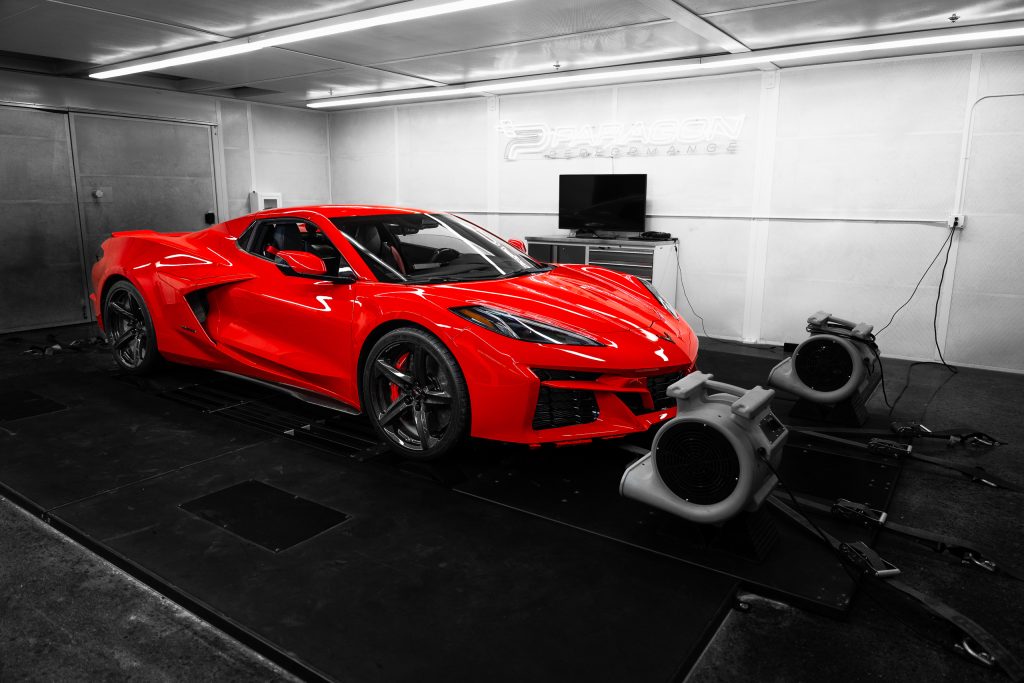
The key thing to pay attention to here is that these numbers are “at the flywheel,” better known as BHP. Almost every car, save for some extremely efficient EV’s, has parasitic loss between the engine and the wheels, by nature of having to overcome inertia and keeping the moving bits moving. In general, you’re looking at anywhere between 10% for a hyper-efficient hybrid, to up to 35% for an AWD car depending on how many transfer boxes and differentials the power needs to go through.
With that said, Paragon Performance out of Des Moines, Iowa, recently put an E-Ray on an all-wheel dynamometer after it was driven the 600 miles for the break-in as part of the delivery. That’s all the running it’s had, so consider that the numbers they report are about as factory fresh as you can get.
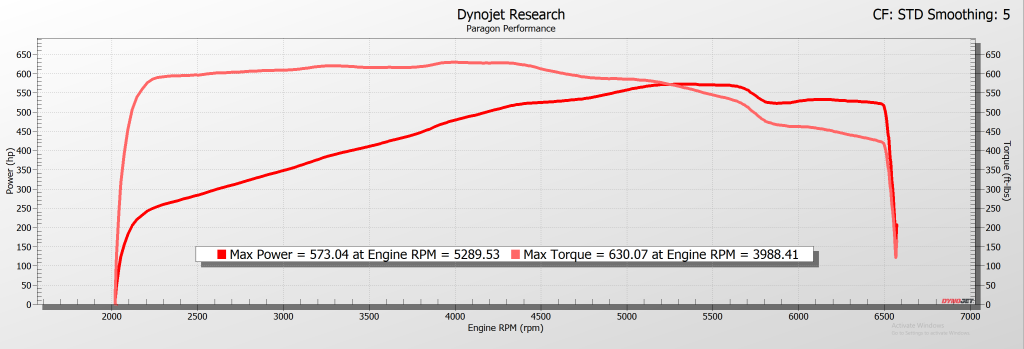
The result of the dyno run was that the Corvette C8 E-Ray put down 573 HP and 630 lbs-ft of torque at the wheels (aka WHP). As well, as you can see by the dyno graph below, there isn’t so much a torque curve as there is a torque plateau, as the electric motor up front provides instant and constant torque from 1 RPM on up.
Comparison vs The Stingray & The Z06
The standard Corvette C8 Stingray is claimed to have 495 HP and 470 lbs-ft of torque at the flywheel. Paragon Performance has had more than one of those on their dyno, and even taking the best result they got, it’s still astonishing just how much more powerful the E-Ray is.
The dyno result they present is 437.4 HP and 419.56 lbs-ft of torque at the wheels, meaning the C8 suffers just about 12% of parasitic loss, mostly because the power goes directly through the transaxle to the wheels, instead of having to spin a driveshaft from the front to the rear of the car like all the Corvettes before it.
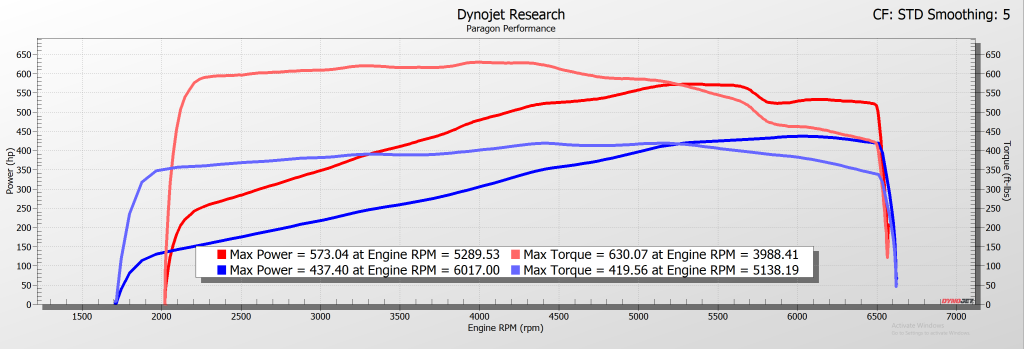
In pure numbers, the E-Ray is 135 WHP more powerful than the Stingray, and has over 210 lbs-ft more torque thanks to the electric motor. That is also why the E-Ray, in launch mode in perfect conditions can get to 60 MPH in 2.4 seconds, and the Stingray reaches that same mark in 2.9 seconds.
The more competitive comparison is against the road-going race car that the Corvette C8 Z06 is, with a claimed 670 HP and 460 lbs-ft at the flywheel. Paragon Performance doesn’t seem to have a Z06 run on their site, but other dyno runs have come in at an average 610 HP and 415 lbs-ft of torque at the wheels, representing an impressively low parasitic loss of only 9%.
Yet, even with the flat plane V8 in the back, weight savings all around, and launch control, the Z06 is still going to be seeing the E-Ray’s tail lights in a drag race as it achieves 0 to 60 in 2.6 seconds.
On the track, the Z06 might hold a small advantage due to it literally being designed for racing, but the E-Ray will still be very close behind it, as the hybrid motor will help haul it out of corners with much better power. The Stingray, while a very fine car, will be seeing both their tail lights around a place like Road America or Laguna Seca, as it just isn’t in the same league in terms of actual power and performance.
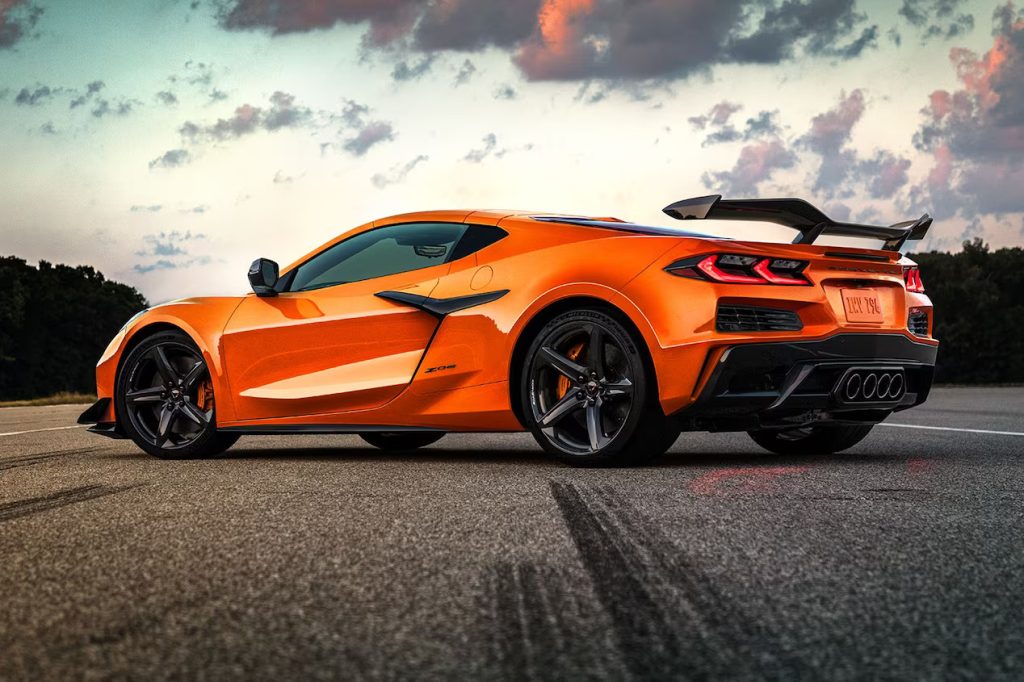
Basically, what Chevrolet have managed to achieve is on par with cars from places like Italy and the UK, big names with Formula One racing pedigree in their blood, putting out a car that is probably the best “Supercar killer” to ever wear the Corvette badge. While it’s not a hypercar, it does deserved to be labelled a supercar, as the biggest thing about it is that because it’s American, it’s not going to cost you your firstborn and have you remortgage your house.
How they are managing to put it on sale for just $106,595 MSRP is absolutely mind-boggling. This is a car that can beat a Ferrari 296 GTB and a McLaren Artura to 60 MPH, and hang with them around a track in fine style, yet costs a third of the price. This is one of those cars that comes around every generation that redefines what affordable performance means. It’s not exactly cheap, but there is a reason that the waitlist for an E-Ray is already approaching 1.5 years long.
Not that we’re complaining, not one bit!
Just remember, there’s also the actual Corvette hybrid hypercar coming as well, the C8 Zora. If the E-Ray is anything to go off of, we’re in for one hell of a car when it finally does come out.


